Keywords
|
| Visual cryptography; Compression; DCT; Random grid; Shares; Steganography |
INTRODUCTION
|
| In the recent communication technology, the needs for information exchange and transfer have increasedexponentially. In the public domain the threat of an intruder accessing secret information has been an ever existingconcern for the data communication. Steganography, Cryptography, and Visual cryptography are the most widely usedtechniques to overcome these threats. |
| In Cryptography the plaintext is transformed (encrypting it) into an unreadable format, which is called ascalled cipher text. Only those who possess a secret key can decipher (or decrypt) the message into plain text. Insteganography a message, image, or file is embedded within another message, image, or file. Both these techniquesprovide some level of security of data. In VC the image is encrypted by creating random shares and decryption is doneby human eyes. However, neither of them alone is secure enough over an unsecure communication channel for sharinginformation and is vulnerable to intruder attacks. Although these techniques are often combined together to achievehigher levels of security, in order to minimize the threat of intrusion we still need a highly secured system to transferinformation over any communication media. |
| For any communication system, a secure transmission of information can be achieved using a powerful encodingalgorithm and a fast transmission to send the information from a transmitter to a receiver (that can be done using anefficient compression technique) is two important requirements. To satisfy these constraints, we propose a new methodof compression and encryption at same time. |
| The image is initially encrypted by visual cryptography using random grid scheme by generating random shares.Then we cover the random share with a cover image. Our proposed method is based on the hiding of information(Embedding) in the transmitter side and taking out (Extracting) algorithm in receiver side the decoding phase. Inaddition we would like to compress the transmitting data, to achieve a high speed communication. |
| For this purpose Discrete Cosine Transform (DCT) is utilized because most of the power is concentrated in thelower frequency bands by DCT, it is used to cut out the higher frequency components. Then the compressed DCTelements are rotated, the rotations have another aspect. The directions and degrees of the rotations are saved as “key” torestore the original images. If the receiver does not know “key,” it is hard to recover the original images. |
| The digital embedding method proposed for hiding an image into another image helps to maintain the quality of thereconstructed image. The image file, which is to be hidden, is termed as Target Image (share image) and the imagebehind which it is to be hidden is termed as Cover Image. In this paper the whole process is divided into transmitterside process and receiver side process. |
RELATED WORK
|
| Visual cryptography (VC) is a novel concept first introduced by Naor and Shamir [1] in 1994. VC allows one ormore images to be encrypted and subsequently decrypted. In VC decryption of an image encrypted by a visualcryptography scheme requires no mathematical computations or knowledge of cryptography. Instead, the originalimage becomes visible to the naked eye simply by overlaying cipher transparencies known as shares created during theencryption process. In the (k, n) VC scheme (2 ≤ k ≤ n), the secret image is encoded into n transparencies, calledshares, only if at least k shares are superimposed together can reveal the secret image, but no information can beobtained by any less than k shares. Ateniese et al. proposed the Extended Scheme for Visual Cryptography (EVCS)which allowed for meaningful content in the cover-image to appear on the share-image [2]. However VC uses pixelexpansion method to decompose the secret image, the share-images are larger than the original secret image. Thedrawbacks of this are image distortion, wastage of storage space, and the share-images are difficult to carry. Since theconcept of visual cryptography was first proposed, there have been several researches making efforts to deal with thepixel expansion problem. Most of these have fallen into the category of probability visual cryptography schemes.Random Grid Encryption Algorithms for Binary Images Was proposed by Kafri and Keren [3] aiming at theminimization of the pixel expansion. The biggest benefit of the RGVSS method for encryption is that it generatesunexpanded share-images. In 2007 Shyu [4] extended Kafri and Keren’s RGVSS model, he proposed three differentmodels utilizing a (2, 2)-threshold scheme. Shyu [5] and Chen and Tsao [6] also discussed about (2, n) - and (n, n)-threshold RGVSS schemes, so this method is no longer limited to the (2, 2)-threshold scheme. Transmission of ameaningless image can arouse the suspicion of an intruder, who may realize that this image may carry some type ofsecret message. This attracts attention and could strengthen their desire to uncover the secret image, thus decreasing thesecurity of the share-image. Ateniese et al. [7] first applied the strategy of steganography to generate meaningful shareimagesin VC. Following Ateniese, Chang et al. [8] found a way to hide a color secret image in two color cover images.Thien and Lin [9] introduced a pixel non-expansion method that could produce a meaningful share-image but acomputer was needed to decrypt the secret image, losing the advantage of visual cryptography which is decryptiondirectly by the human eye. |
| Many researches were carried out to combine the encryption and compression technique, to reduce the amount ofspace required to store the secret data, for faster communication and better security of secret data. Andrew B. Watsonintroduced Image Compression Using the Discrete Cosine Transform in 1994[10]. A. Alfalou C. Brosseau et al. [11]performed compression based on the discrete cosine transform (DCT). Two levels of encryption are used. The first oneis due to the grouping of the DCTs in the spectral domain and after a second transformation, i.e. to hide the targetimages; one of the input images is used as encryption key. The compression is better than JPEG in terms of PSNR.Maher Jridi, Ayman Alfalou [12] presented a method that utilizes the DCT properties to achieve the compression andthe encryption simultaneously. First for compression, 8-point DCT applied to several images. Second, only somespecial points of DCT outputs are multiplexed. For the encryption process, a random number is generated and added tosome specific DCT coefficients. Image Encryption Using DCT and Stream Cipher were proposed in 2009[13]. Theproposed method based on the idea of decomposing the image into 8x8 blocks, these blocks are transformed from thespatial domain to frequency domain by the DCT. Then, the DCT coefficients correlated to the higher frequencies of theimage block are encrypted using Non-Linear Shift Back. New Image Encryption and Compression Method Based onIndependent Component Analysis were proposed in 2007[14]. In this new method is proposed combining encryptionand compression based on ICA and Discrete Cosine Transform (DCT). In this paper a combination of steganography,random grid visual cryptography and DCT based compression technique is applied in order to achieve the highersecurity levels and for faster transmission of information. |
APPROACH
|
| Flow of our approach to transmit encrypted and compressed images to approved folks is illustrated. In theencryption stage the image is encoded into two shares by applying random grid visual cryptographic scheme (RGVCS). The shares have same size as that of original image. Then, we are dividing the share images into tiny blocks and applytwo-dimensional Discrete Cosine Transform (DCT) separately of every block. |
| With the property of the DCT transform that regroup the vital data within the upper-left corner; we are ableto simply choose this desired data by applying an easy low pass filter to compress them. Thus we can cut back thesize of data to be transmitted. After the choice of desired info, we'll encode them by grouping along (merging) theinformation coming back from many DCT parts of the images within the spectral plane. As a result of the DCTcomponents of natural images have high energy in lower frequency bands; DCT parts of various sources might notbe independent. To resolve this downside and acquire associate freelance version of those DCT parts, we have atendency to rotate every DCT block at random. Moreover, the rotation operation is going to be used asassociate adding secret writing key. This latent key should be sent to the receiver so as to build the decrypted images.Then the compressed image is embedded in random cover image using LSB technique. In LSB based Steganographythe secret data is embedded in to the least significant bits of the pixel values in a cover image. |
| In the decryption stage we extract the original image from the cover image this process is termed as extraction.Then the DCT components are rotated and decompressed based on the information of the encryption keys. In the nextstep we apply Inverse Discrete Cosine Transform (IDCT) to the reconstructed DCT components to obtain the originalshare images. Finally the share images are overlapped to obtain the original image. |
PROPOSED WORK
|
| A. Visual Cryptography Using Random Grids |
| While the approach by Naor and Shamir [1] offers excellent security once one possesses solely one share, it suffersfrom the requirement to represent every pixel within the original image by multiple pixels in every share, leading to adecrypted image that's 2-4 times larger than the first image. This technique needs additional time to encrypt and decryptimages as well as to transfer encrypted images across a network. |
| A scheme was proposed by Kafri and Keren [3] that did not require the use of pixel expansion through the use ofrandom grids (RG). RG scheme takes an input image and transforms it into multiple cipher-grids that give noinformation on the original image. However, RG schemes have the additional advantage that they require no pixelexpansion, and thus each share and the resulting decrypted image retains the size of the original image. Kafri and Kerenproposed three similar 2 out of 2 algorithms employing random grids in 1987. Qualitative testing disclosed that the firstalgorithm they present produces results superior to those produced by the others, so this formula is hand-picked fordiscussion. |
| Algorithm |
| Step 1: Generate R1 as a random gridStep 2: for (each pixel R1 [x, y], 1 ≤ x ≤ w and 1 ≤ y ≤ h) doStep 3: R1 [x, y] = rand_pixel (0, 1)Step 4: for (each pixel B [x, y], 1 ≤ x ≤ w and 1 ≤ y ≤ h) doStep 5: {if (B[x, y] = 0) R2[x, y] = R1[x, y]else R2[x, y] = R1[x, y ]}Step 6: output (R1, R2) |
| Note that rand_pixel (0, 1) is a function that returns a binary 0 or 1 to represent an opaque or transparent pixel,respectively, by a coin coin-flip procedure. Here the initial grid R1 is a combination of random collections of zeros andones. Second grid R2 is next generated based on the input image and R1. This process occurs by scanning each pixel ofthe input image. If a pixel at location [x, y] in the input image is found to be white, then the pixel R2[x, y] is set to bethe same as R1[x, y]. If, instead, the pixel at [x, y] in the input image is black, then the pixel R2[x, y] is set to be thecomplement of R1[x, y]. The decryption process takes place by superimposing the two random grids pixel by pixelusing OR operation which is identical to that of Naor and Shamir's 2 of 2 algorithm. |
| B. Transmitter Side Process |
| 1) Encryption of Image Using Random Grid Technique: The original image is encrypted by creating the randomshares based on visual cryptography using random grids. Each share contains collection of random pixels. No singlerandom share reveals the secret information |
| 2) Discrete Cosine Transform: Process the random share image in small blocks and apply two-dimensional discretecosine transform to each block and we obtain DCT components of each block. |
| 3) Compression: The share of the image to be placed in the cover image is compressed to be space efficient. In orderto achieve objective, a lossy compression technique DCT is used for compressing the share. Lossy compression is adata encoding method which compresses data by discarding (losing) some unwanted portion of it. |
| In each block, most of DCT components have high energies in low frequency bands; we only require low frequencycomponents. The low frequency components we can get through a simple low pass filter that is, left-up corners of eachblock with size of NC × NC are selected and higher frequency components are dropped. As a result of this process wecan compress the transmitting images. |
| 4) Rotation and Embedding: After the compression we have to rotate the each small block randomly, so as to makerotated DCT components be independent of each other. The compressed rotated image is covered by a random imageand sends to Destination over a transmitting media. |
| C. Receiver Side Process |
| 1) Extraction: In order to extract the original image, authorized people receive the mixtures and turns back the rotatedDCT components and using inverse discrete cosine transform (IDCT), so that the original images are decrypted. |
| 2) Inverse Rotation and Inverse Cosine transform: The original image and random image should separated in order toreconstruct the original image. The rotated DCT components have to be restored. The receiver is beforehand given therotation “key” by the transmitter. Using this rotation “key”, the receiver can reconstruct the original images. Withoutrotation key, it is difficult to reconstruct the original DCT components. Finally the receiver can obtain the estimatedoriginal images from the observed mixtures by applying inverse discrete cosine transform (IDCT) to DCT components. |
| 3) Decryption of Image: The shares and cover images are separated during extraction. The obtained shares aresuperimposed to get the original secret image. |
| Algorithms |
| Transmitter side algorithm: The transmitter side algorithm describes the encryption stages of the secret informationas follows: |
| Algorithm 1 |
| • Step1: Take an image as input. • Step2: Encrypt the image by creating shares by the VC using random grid technique. Each share is treated as information.• Step3: First divide the share (target image) into blocks.• Step4: Apply DCT (Discrete Cosine Transformation) on each divided blocks.• Step5: Then rotate the DCT blocks keep the direction of rotation as key for reconstructing the image.• Step6: Then embed the share image with another random cover image.• Step7: The random image is also divided into blocks and applies DCT on each block and the original image iscovered by random image and it is send to the destination. This process is called embedding. |
| Receiver Side Algorithm: The Receiver side algorithm describes the decryption stages of the secret as informationas follows. |
| Algorithm 2 |
| • Step1: The random image is taken out. The share image or target image and random image are separated. Thisprocess is called extraction• Step 2: The DCT blocks are reconstructed for the source image using the rotation key.• Step 3: Then inverse DCT is applied to each block• Step 4: The share image is reconstructed.• Step 5: Finally the extracted shares are superimposed to get the original image. |
SIMULATION RESULT
|
| The simulation results are shown below. We have taken a 256×256 binary image as original image. Fig 1 shows thecreation two shares using random grid technique. The sizes of the shares are same as that of the original image. Fig 2shows the two compressed shares generated using DCT compression technique. Fig 3 shows the two 256×256 moonand clock cover images. Fig 4 shows the compressed cover images. Fig 5 shows the secret embedded cover imagesusing lsb substitution. Fig 6 shows extracted decompressed shares from cover images. And finally the fig 7 showsoriginal secret image obtained by overlapping both the shares. We can observe that the quality of the reconstructedimage is not same as that of the original image because of the high compression ratio. The table 1 gives the PSNR ofthe compressed share image to compressed extracted image based on the number of LSB bits substituted in the cover image. The PSNR of the original share image before compression to extracted final decompressed share image is31.4756. The compression can be given by |
 |
| We found that initial size of the share is 65KB and compressed share is 5KB. Hence compression ratio is 13. |
CONCLUSIONS AND FUTURE WORK
|
| Visual cryptography is that current space of analysis wherever heap of scope exists. There are various innovativeideas and extensions exist for the basic visual cryptographic model introduced till now. In the existing VC schemes nosecurity is provided to the secret shares and intruder can alter its bit sequences to create fake shares. In this paper weproposed a steganography, visual secret sharing scheme and the combination of both. Therefore it provides higherlevels of security to the information being transmitted. That is the intruders cannot easily break the system. Even if theyrealize the existence of a secret data they cannot easily recognize the data, since data is hidden in two ways. And weproposed a new image compression and encryption technique based on Embedding and Discrete Cosine Transform(DCT).Binary secret shares are compressed using DCT. In the encryption process DCT blocks of transmitted sharesrotated and covered with a random image to hide them. In the decryption process the covered binary secret shares canbe extracted from the mixtures by applying extraction algorithm. Finally the original images can be reconstructed usingrotation keys and inverse discrete cosine transform. This DCT based compression technique can also be applied tomany VC schemes which suffer from huge share size problem. Therefore we can achieve a secure and fast imagetransmission. In this we have taken only binary image. The method can be applied to grayscale and binary images inthe same way. |
| Our future works embody a safer secret writing technique with an alternate rotation technique and a reconstructionkey. Additional advanced rotation manner makes it tougher for unauthorized individuals to reconstruct pictures withoutkeys. Mean while the attention is given to improve the quality of the reconstructed image. Cryptography techniqueslike RSA, AES and hash functions can also be used with steganography to provide more security. |
Tables at a glance
|
 |
| Table 1 |
|
| |
Figures at a glance
|
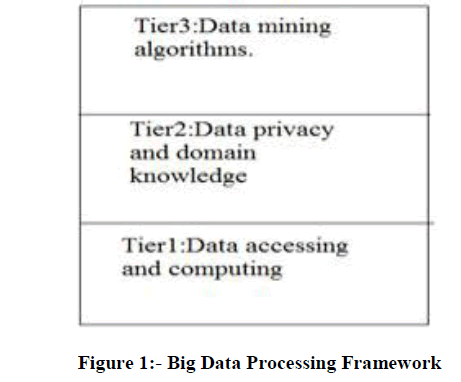 |
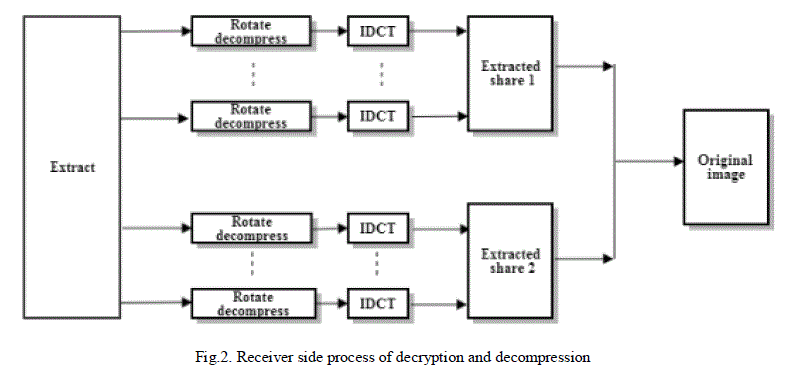 |
 |
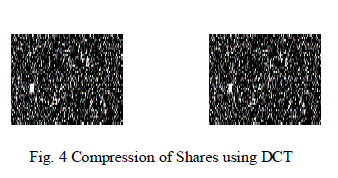 |
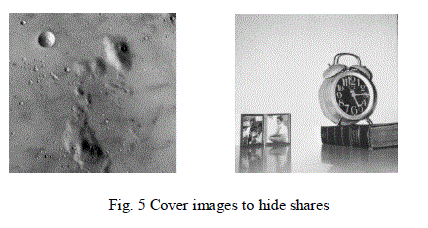 |
| Figure 1 |
Figure 2 |
Figure 3 |
Figure 4 |
Figure 5 |
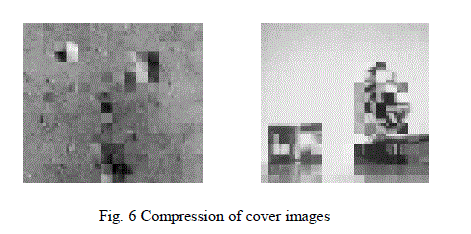 |
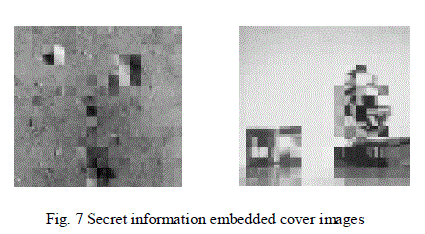 |
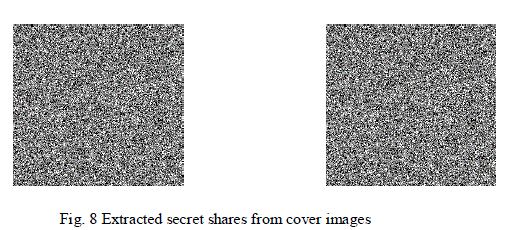 |
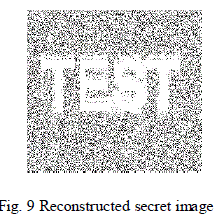 |
| Figure 6 |
Figure 7 |
Figure 8 |
Figure 9 |
|
| |
References
|
- M. Naor and A. Shamir, “Visual cryptography,” in Advances in Cryptology-EUROCRYPT ’94, LNCS 950, Springer-Verlag, pp. 1- 12,1995.
- Ateniese G., Blundo C., De Santis A., and Stinson D. R., “Visual cryptography for general access structures,” Information and Computation, 129,86-106, 1996.
- O. Kafri and E. Keren, “Encryption of pictures and shapes by random grids,” Optics Letters, vol. 12, no. 6, pp. 377-379, June 1987.
- S. J. Shyu, “Image encryption by random grids,” Pattern Recognition, vol.40, no. 3, pp. 1014-1031, 2007.
- S. J. Shyu, “Image encryption by multiple random grids,” Pattern Recognition, vol. 42, no. 7, pp. 1582–1596, 2009
- T. H. Chen and K. H. Tsao, “Visual secret sharing by random grids revisited,” Pattern Recognition, vol. 42, no. 9, pp. 2203-2217, 2009.
- G. Ateniese, C. Blundo, A. De Santis, and D. R. Stinson, “Extended schemes for visual cryptography,” Theoretical Computer Science, vol.250, pp.143-161, 2001
- C. C. Chang, W. L. Tai, and C. C. Lin, “Hiding a secret color image in two color images,” Imaging Science Journal, vol. 53, no. 4, pp. 229–240,2005
- C. C. Thien and J. C. Lin, “An image-sharing method with user-friendly shadow images,” IEEE Transactions on Circuits and Systems for VideoTechnology, vol. 13, no. 12, pp. 1161–1169, 2003.
- Andrew B. Watson “Image Compression Using the Discrete Cosine Transform”, NASA Ames Research Center, Mathematica Journal, 4(1), p. 81-88,1994
- A. Alfalou C. Brosseau, N. Abdallah, and M. Jridi,“Simultaneous fusion, compression, and encryption of multiple images”, OPTICS EXPRESS24024Vol. 19, No. 24 OSA, 2011
- Maher Jridi and AymanAlFalou, “A VLSI Implementation of a New Simultaneous Images Compression and Encryption Method”, IEEE-978-1-4244-6494-4/10, 2010
- LalaKrikor, Sami Baba, ThawarArif, ZyadShaaban , Faculty of Information and Technology, Applied Science University, “Image EncryptionUsing DCT and Stream Cipher,” European Journal of Scientific Research, Vol.32, No.1 , pp.48-58,2009
- Masanori Ito, Noboru Ohnishi, AymanAlfalou and Ali Mansour, “New Image Encryption And Compression Method Based On IndependentComponent Analysis”, IEEE, 2007.
|